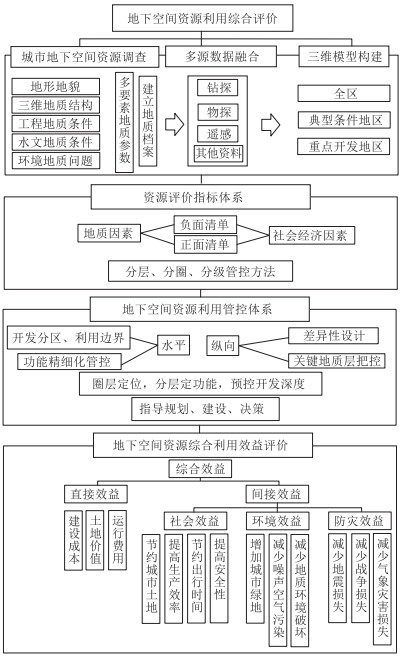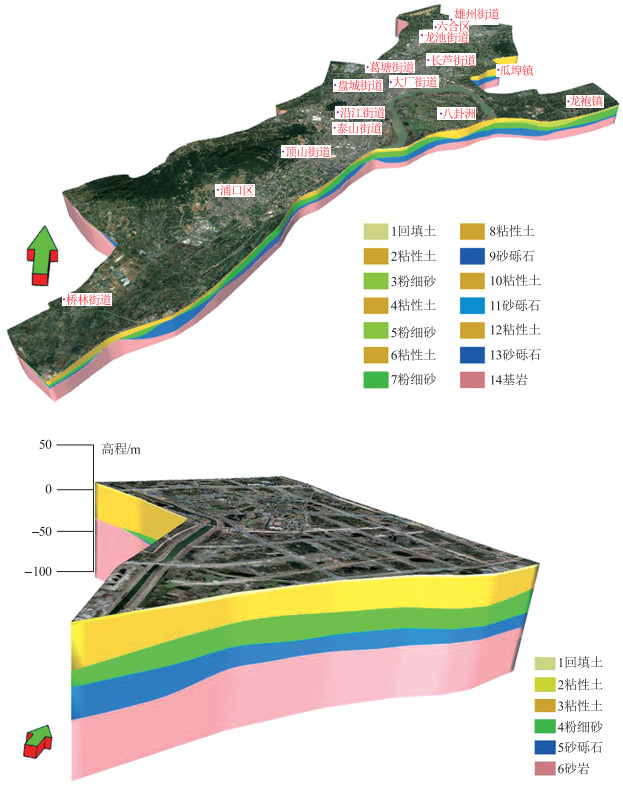Conception of comprehensive utilization evaluation of urban underground space resources
-
摘要:
实现地下空间的安全开发和管理是当前中国构建全域国土空间治理体系的重要组成部分。当前中国地下空间资源综合评价在运用地质成果、对接国土空间规划、数据共享服务方面面临不足与挑战,表现在地质调查缺少高精度的成果和足够的系统性,规划管理实施过程中没有实现对评价成果的充分利用,地质调查成果和空间利用信息的融合度急需提高,长期以来城市地下空间资源利用"无法可依"、"无据可依"、"有规划难执行"。针对这些不足,提出了地下空间资源调查与综合评价体系——地下空间规划管控体系的构想,即科学安全地开发利用城市地下空间资源,应以规划管控为导向,开展三维地质结构调查,构建地下空间资源三维地质结构模型;综合考虑地质条件、地下空间开发利用现状、地下应急水源地、地下文物保护等多种因素,系统评价地下空间资源潜力,构建地下空间多种资源综合协同开发利用的管控评价体系。开展地下空间资源综合开发利用评价研究,对拓展城镇化发展新空间、开辟城镇化建设新资源、构建全域国土空间治理体系、统筹国土空间资源规划管理意义重大。
Abstract:To realize the safe development and management of underground space is an important part of China's overall territorial space governance system.Currently, the comprehensive evaluation of underground space resources in China is facing new challenges due to its shortcomings in the application of geological achievements, docking of territorial space planning and data sharing services.Problem lies in the lack of high precision of geological survey results and enough systematic, not implemented in the process of planning implementation management to make full use of the evaluation results, geological investigation results and space urgently needs to improve the use of information of alignment. As a result, the utilization of urban underground space resources is often "impossible to rely on", "no evidence to rely on" and "difficult to implement planning" for a long time.In view of these shortcomings, the concept of underground space resources investigation and comprehensive evaluation system- underground space planning and control system is proposed, that is, to develop and utilize urban underground space resources in a scientific and safe manner, a three-dimensional geological structure investigation should be carried out with planning and control as the guide, and a three-dimensional geological structure model of underground space resources should be constructed.Through comprehensive consideration of geological conditions, development and utilization status of underground space, underground emergency water source, protection of underground cultural relics and other factors, the underground space resource potential is systematically evaluated, and the comprehensive coordinated development and utilization control and evaluation system of various underground space resources is constructed.The study on the comprehensive development and utilization of underground space resources is of great significance to the expansion of new space for urbanization development, the opening up of new resources for urbanization construction, the construction of a territorial space governance system for the whole region, and the coordination of territorial space resource planning and management.
-

-
表 1 城市地下资源开发引起的典型灾害统计
Table 1. Statistics of typical disasters caused by urban underground resources development
灾害类型 年份 典型案例 伤亡人数/损失 地面塌陷 2020 西宁市南大街 10死17伤 2019 广州地铁11号线施工区 3人死亡 2019 青岛地铁4号线施工区 5人死亡 2018 四川达州市 2死2失踪 2008 杭州风情大道地铁施工区 17死24伤4失踪 涌砂涌水 2018 广东佛山市轨道交通2号线 12人死亡 2015 西安地铁4号线试验段 地下管道、排污系统受损 2014 武汉地铁4号线复兴路站 附近建筑开裂 2012 广西南宁市地铁施工 公交车陷入陷坑 -
[1] Pajunen M, Airo M L, Elminen T, et al. Construction suitability of bedrock in the Helsinki area based on the tectonic structure of the Svecofennian crust of southern Finland[J]. Special Paper Geological Survey of Finland, 2008, 2008(47): 309-326. http://www.researchgate.net/profile/Meri-Liisa_Airo/publication/265918133_Construction_suitability_of_bedrock_in_the_Helsinki_area_based_on_the_tectonic_structure_of_the_Svecofennian_crust_of_southern_Finland/links/54d334260cf2b0c6146d150a.pdf
[2] Kimmo R, Jouko R, Kari R. Under-ground space in land use planning[J]. Tunnelling and Underground Space Technology, 1998, 13(1): 39-49. doi: 10.1016/S0886-7798(98)00029-7
[3] Malone A W. The use of underground space in Hong Kong[J]. Tunnelling & Underground Space Technology, 1996, 11(1): 57-64.
[4] Zhou Y, Zhao J. Assessment and planning of underground space use in Singapore[J]. Tunnelling & Underground Space Technology Incorporating Trenchless Technology Research, 2016, 55(5): 249-256. http://www.onacademic.com/detail/journal_1000038585282810_ff9d.html
[5] Raymond L S, Susan R N. Planning for underground space: a case study for Minneapolis, Minnesota[M]. New Jersey: John Wiley & Sons, 1982: 21-40.
[6] Maurenbrecher P M, Herbschleb J. The potential use of geotechnical information systems in the planning of tunnels for Amsterdam[J]. Tunnelling & Underground Space Technology, 1994, 9(2): 189-199. http://www.onacademic.com/detail/journal_1000034577532710_a209.html
[7] Bobylev N. Underground space in the Alexanderplatz area, Berlin: Research into the quantification of urban underground space use[J]. Tunnelling and Underground Space Technology, 2010, 25(5): 495-507. doi: 10.1016/j.tust.2010.02.013
[8] Bobylev N. Mainstreaming sustainable development into a city's Master plan: A case of Urban Underground Space use[J]. Land Use Policy, 2009, 26(4): 1128-1137. doi: 10.1016/j.landusepol.2009.02.003
[9] 祝文君. 北京旧城区浅层地下空间资源调查与利用研究[D]. 清华大学硕士学位论文, 1994.
[10] 黄玉田, 张钦喜. 北京市中心区地下空间资源评估探讨[J]. 北京工业大学学报, 1995, 21(2): 93-99. https://www.cnki.com.cn/Article/CJFDTOTAL-BJGD502.014.htm
[11] 林树枝, 黄建南, 耿家强. 地下空间工程适宜性探讨[J]. 福建建设科技, 2009, (6): 4-7. doi: 10.3969/j.issn.1006-3943.2009.06.002
[12] 彭苗枝, 包海玲, 刘道彬, 等. 地下空间工程地质适宜性灰色评估[J]. 采矿技术, 2010, 10(3): 114-116. doi: 10.3969/j.issn.1671-2900.2010.03.042
[13] 彭建, 柳昆, 郑付涛, 等. 基于AHP的地下空间开发利用适宜性评价[J]. 地下空间与工程学报, 2010, 6(4): 688-694. https://www.cnki.com.cn/Article/CJFDTOTAL-BASE201004007.htm
[14] 柳昆, 彭建, 彭芳乐. 地下空间资源开发利用适宜性评价模型[J]. 地下空间与工程学报, 2011, 7(2): 219-231. https://www.cnki.com.cn/Article/CJFDTOTAL-BASE201102004.htm
[15] Li X Z, Li C C, Parriaux A, et al. Multiple resources and their sustainable development in Urban Underground Space[J]. Tunnelling and Underground Space Technology, 2016, 55(5): 59-66. http://www.onacademic.com/detail/journal_1000038607727910_f15f.html
[16] 吴立新, 姜云, 车德福, 等. 城市地下空间资源质量模糊综合评估与3D可视化[J]. 中国矿业大学学报, 2007, 36(1): 97-102. https://www.cnki.com.cn/Article/CJFDTOTAL-ZGKD200701019.htm
[17] Chen Z L, Chen J Y, Liu H, et al. Present status and development trends of underground space in Chinese cities: Evaluation and analysis[J]. Tunnelling & Underground Space Technology, 2018, 71: 253-270. http://www.onacademic.com/detail/journal_1000040083310210_a93b.html
[18] 陈志龙. 中国城市地下空间发展蓝皮书2019[EB/OL](2019-10-01)[2020-08-09]. http://www.wisusp.com/?page_id=2199.2020.
[19] 王成善, 周成虎, 彭建兵, 等. 论新时代我国城市地下空间高质量开发和可持续利用[J]. 地学前缘, 2019, (3): 1-8. https://www.cnki.com.cn/Article/CJFDTOTAL-DXQY201903003.htm
[20] 束昱. 地下空间资源的开发与利用[M]. 上海: 同济大学出版社, 2002.
[21] 孙晓玲, 韦宝玺. 加强城市地下空间资源管理的思考[J]. 中国国土资源经济, 2017, 30(4): 26-29. doi: 10.3969/j.issn.1672-6995.2017.04.007
[22] 黄莉, 王直民, 鲍海君, 等. 城市地下空间的资源属性与开发特性分析[J]. 上海国土资源, 2018, (2): 37-40. doi: 10.3969/j.issn.2095-1329.2018.02.009
[23] 王直民, 鲍海君, 彭毅, 等. 中国城市地下空间研究范式的转移与扩张[J]. 中国土地科学, 2017, (5): 62-69. https://www.cnki.com.cn/Article/CJFDTOTAL-ZTKX201705008.htm
[24] 张智峰, 刘宏, 陈志龙. 2016年中国城市地下空间发展概览[J]. 城乡建设, 2017, (3): 60-65. doi: 10.3969/j.issn.1002-8455.2017.03.023
[25] 杨洋, 程光华, 苏晶文. 地下空间开发对城市地质调查的新要求[J]. 地下空间与工程学报, 2019, 15(2): 4-10. https://www.cnki.com.cn/Article/CJFDTOTAL-BASE201902001.htm
[26] DZ/T 0306-2017城市地质调查规范[S]. 中华人民共和国国土资源部, 2017
[27] 王洋, 彭芳乐. 地下空间社会与环境效益的定量评价模型[J]. 同济大学学报(自然科学版), 2014, 42(4): 659-664. doi: 10.3969/j.issn.0253-374x.2014.04.025
[28] 姜
[29] 王洋. 城市地下空间开发防灾效益定量化评价研究[C]//运用安全与节能环保的隧道及地下空间暨交通基础设施建设学术研讨会, 2012.
-




 下载:
下载:
